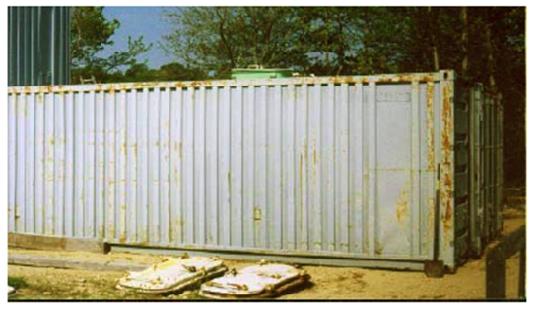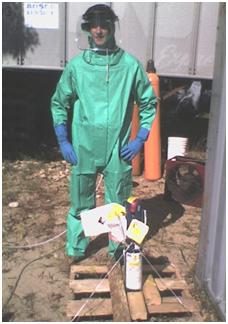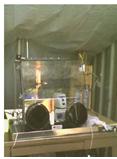Chembio Defeat
We have worked with various DoD agencies on chemical,and biological agent detection, characterization and defeat. We have also assisted them with preparedness (including vulnerability assessment) and environmental clearances to perform large scale tests and disposal of energetic waste. Our work over the years focused on development and testing; Consequence analysis of military attacks on various targets (both with conventional weapons and emerging technologies such as High Energy Lasers and Reactive Material Payloads).
- Chemical and Biological Agents
- Detection: Morphological Characterization and Material Property Characterization
- Consequence Analysis:
- Modules of ADORA have been integrated into DTRA HPAC suite
- H2OFate models the fate and transport of chemical and biological agents in drinking water distribution networks
- Defeat
- Pyrolysis
- Combustion: Ignition of Aerosolized Agent and bulk agent; and dust explosion
- Chemical Neutralization
- Case Studies (WMD)
- Morphology Characterization of Biological Agent Spores
- Shock Propagation in Spore Slurries
- Ignition of Aerosolized Spores
- Dust Explosion of Spores
- Other Case Studies
Morphology Characterization of Biological Agent Spores
We performed morphology characterization of biological simulants for Bacillus anthracis spores including Bacillus thuringiensis (Bt) spores and Bacillus subtilis (Bs) spores. For Bt spores, we used Javelin Technical, a commercial pesticide, as the source. Javelin contains various additives in addition to Bt spores. We performed polarized light extinction measurements on Javelin Technical particles suspended in water. Assuming an overall spherical shape for the particulates in Javelin, we inverted the extinction versus wavelength spectrum to determine the size distribution. The resulting size distribution along with an SEM image of pure Bt spores are shown in the figure below. The figure shows that in addition to the spores (size range of 500 - 1500 nm), there are several very fine particulates smaller than 200 nm in Javelin. These could be the spore/cell fragments formed during the spray drying process used for Javelin manufacture, and various proteins and toxins secreted by Bt spores.

Size Distribution of Javelin
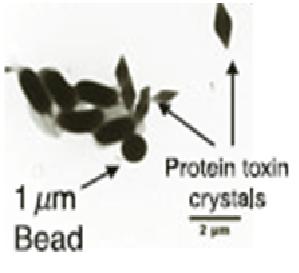
SEM images from Carrerra et al (2007)
We performed similar measurements on two types of Bs spores (1) spores with DPA and (2) spores that have been genetically modified to remove DPA. Assuming an overall ellipsoidal shape for these particulates, we determined their cross sectional area and aspect ratio distribution. These results are shown in the figures below along with an SEM image of Bs spores. These results show that the removal of DPA has almost no effect on the morphology of Bs spores.
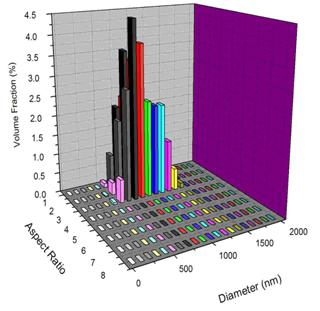
Size & Aspect Distribution of Bs Spores with DPA

SEM images from Carrerra et al (2007)

Size & Aspect Distribution of Bs Spores with no DPA
Material Property Toolkit for Spore Slurries
Through carefully controlled experiments and analysis, we measured the key material properties of Bacillus anthracis spore simulant slurries in water. Based on these measurements, we developed a material property toolkit consisting of the following properties that are necessary to model processes such as hydrodynamic ram, tank failure, agent aerosolization and dispersion:
- Material EOS
- Acoustic speed
- Dynamic viscosity
- Dynamic Surface Tension
- Heat capacity
- Thermal conductivity
- Effect of combined shock and heat on agent viability
Shock Propagation in Spore Slurries
Using an instrumented shock tube, we performed shock propagation studies on Bacillus anthracis simulant slurries in water. We found that at very low concentrations, the slurries behave like pure water. However, at spore concentrations above 2% by weight, the slurries become compressible. The shock waves undergo significant attenuation with travel distance in these slurries. As a result, the shock pressure as well as the shock speed decrease significantly with travel distance. Sample data from one of these tests are plotted in the figure below. The pressure sensors P1 and P4 are 24” apart.
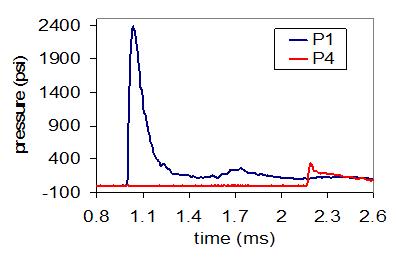
Ignition of Aerosolized Spores
We performed ignition tests on aerosolized spores of pure Bacillus anthracis and its simulant Javelin Technical in an instrumented combustion tube shown below. Photographs depicting the introduction of Javelin particulates into the combustion tube, their ignition and combustion are shown below.

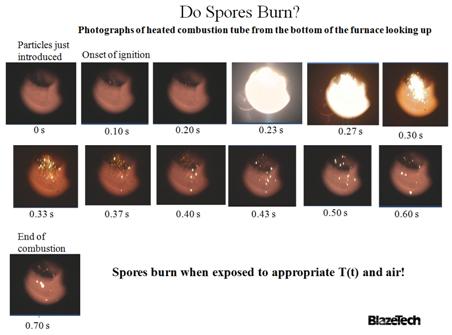
We moved our combustion tube into US Army ECBC BSL-2 facility where ignition tests were performed on pure Bacillus anthracis spores. A photograph of the combustion tube inside a bio containment chamber at the BSL-2 facility is shown below. Based on the measured time to ignition data at various temperatures, we developed an ignition kinetics model for Bacillus anthracis spores. This is the first study of its kind.

Dust Explosion of Spores
Biological agent spores can undergo a grain-silo type explosion in the presence of an ignition source if they are present at an appropriate concentration in a confined region. To examine this further, we performed controlled tests in a 20-L Kuehner vessel shown below. Simulant spores were introduced into the test chamber under turbulent conditions and ignited using a strong ignition source. The chamber pressure was then measured versus time. Based on the measured pressure-time histories at various concentrations, we determined the Minimum Explosible Concentration (MEC) of the spores and developed a model to predict the overpressure versus time from the explosion of spore ducts clouds.
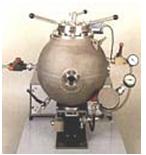
Lethality Assessment and Target Defeat
For the US Department Of Defense, we participated in the design of two large scale test facilities the first to evaluate the effectiveness of various non-energetic payload technologies for the defeat of control and command centers and WMD; and the second to test various advanced energetic materials (including nanoenergetic compositions).
Interhalogens
The high reactivity of interhalogens makes them attractive for the defeat of various targets such as WMDs and electronic equipment at Command and Control Centers.
- Using ADORA, we calculated the hazard contours associated with the release of various amounts of chlorine trifluoride into the atmosphere.
- We assisted the USAF in designing a large scale test facility to evaluate the effectiveness of chlorine trifluoride in defeating various types of targets.
- We developed a technology to improve the safety of handling and storage of bromine trifluoride by gelling it. Photographs of the large steel vessel in which the tests were conducted and the glove bob used for feasibility analysis are shown below. Also shown is a photograph of an operator wearing PPE to prepare the transfer of BrF3 from the supply bottle to test tubes and beakers in the glove box for feasibility studies. Finally a picture of the test tube with gelled BrF3 is shown.
